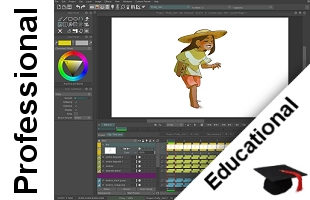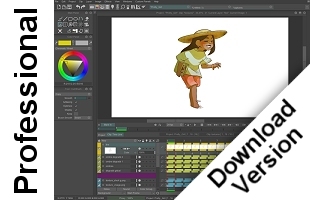
und Audio...
Diese Tutorials (in englischer Sprache) richten sich an TVPaint Animation Neulinge, die zum ersten Mal mit TVPaint arbeiten.
 Your first Drawing with TVPaint Animation
Your first Drawing with TVPaint Animation
 Your first Animation with TVPaint Animation
Your first Animation with TVPaint Animation
 How to use the drawing tools of a conventional animator
How to use the drawing tools of a conventional animator
 How to colorize a character
How to colorize a character
The purpose of this tutorial is to complete the animation sequence that you can download here: Running_Kid (use the option "save the link to" of your internet browser)
Neither the computer nor the software can replace the skill of a real artist. As a consequence, you will have to work by yourself to complete the missing drawings of this animation.
Fortunately, a lot of options of TVPaint Animation will simplify your job!
We saw in the previous tutorial that it was possible to define image layers and animation layers. All those layers together are called TVPaint Animation projects (or simply projects).

The drawing panel will henceforth be called the project window.
Loading a project can be done easily by using the file menu or by using the keyboard shortcut [shift+L] :

The left half of the requester allow to find the folder where the project has been downloaded. The right half of the requester will allow you to select it.

After having loaded the 'running_kid.tvp' file that you have just downloaded, just play it. Did you notice ? Some images are missing...
Well! it will be your job to complete them!
Please select the image n°50 as the current image. This image is one of the missing images.
You can try to draw it directly. But it could be more easy if we could know what is the exact location of the running-kid on the pictures before and after the current one. This is exactly the function of the light table.
The light table is a familiar tool to cartoon and animation artists. It simplifies drawing of the current image by offering a tone-down view of the images before and after the current image
It is accessible with a left click on the light bulb icon in the tool bar or via the Windows main menu :
![]()

This is the way it looks:


The frames in our animation layer which precede and succeed the current frame are displayed on the screen. The frames closest to the current frame « in time » are the most visible and those furthest away « in time » are the most transparent.
The light table is an extremely practical tool as it is also possible to display all frames after the current frame in time and for a given layer.
If you configure your light table as indicated below, the frames before/after the current frame «in time» are displayed in red / in blue, with more or less opacity depending on their position in relation to the current frame.




Now that you understand how this tool works, let's go back and take a closer look at its control panel:
- The two colored boxes (red and blue) allow you to select the colors of your choice to view the frames before and after the current frame,
- The use of colors in this viewing mode is not obligatory. If you wish to keep the original image colors, uncheck the Colors box,
- The sliders are used to manage the opacity level of frames displayed (the Link button avoids having to move each slider individually by linking them to one another)


- The numbers are used to select the frames to be displayed.
For example, in the panels shown as an example above, the number 5 to the right of the zero is selected and its slider is set in the center of the scale. This means that the fifth frame after the current frame will be visible with medium opacity. The number zero enables or disables the light table, its slider manages the global opacity of the table.
Here is an other option which will help you a lot while drawing.
When working with pencil and paper, you often have to turn the page in order to touch-up the lines drawn. This is also possible with TVPaint Animation thanks to the workspace rotation function. This is done by left clicking on the button illustrated opposite in the current project window and then moving the mouse.

A right click on this button offers access to predefined worktop rotation values.
You may also use the keyboard shortcuts [Ctrl+Shift+PageUp/PageDown] or [insert] to reset the rotation angle.


Above to the right you will find all information relative to your project (including the workspace rotation angle) which is accessible by placing the cursor on the project title bar.
It is possible to play your animation with a tilted workspace!
Note that workspace rotation always takes place from the center of your project window.
If necessary, you may use the bottom and right-hand sliders of your project window to position the latter...
When the workspace is rotated, it becomes visible in the form of an animation disk. If you do not need this function, it may be disabled in the Display popup menu of the current project.
Animation artists who prefer to use the Animator fields may use the same menu to select this option.


It is possible to flip your images around the horizontal, vertical or both axes:




To do this, simply use the main menu options Image > Modify > Flip (Horizontally, Vertically or Both) an image or the selected images.
Sometimes, you can need to work more accurately. Instead of moving closer to the screen or changing the screen resolution, you can use the zoom option. What you need to do is to use the '+' and '-' buttons of the project window.

An other possibility consists in using the navigator panel hereafter:

Note that you have the display menu at your disposal in the navigator panel. The display menu allows you activate the animation disc and the animation fields.




Well, here is the situation: you have just drawn one of the missing image thanks to the light table and the rotative drawing disk. It is now time to do test the animation:
Of course, you can use the play option of the drawing window, but there are two disadvantages:
- Firstly, you have to play the animation from the beginning and this could waste some time for big animation.
- Secondly, you will change the current image.
In fact, if you want to take a look at the quality of your work, you will necessary activate the stop button after your current image (so the current image will be changed) .
Fortunately, the flip-book option has been added in TVPaint animation 8 (older TVPaint softwares don't have it).
If you push the animation button of the project window, a few pictures before and after the current image will be played and after that, the software will bring you immediately on the current picture.


Here, the missing image has been drawn in blue, and the flip-book option has been used.
This very convenient to... draw, make a test, touch up the current image, make an other test, etc...
It is sometimes useful to go from an image to another one, without searching in the timeline where is the needed image. For example, you may need to navigate through the breakdowns of this walk cycle only. This could be done easily, thanks to the bookmark feature.
Let now consider the pictures where the running-kid's foot lay on the ground.


It is possible to bookmark those pictures in the timeline, by using the encircled flag button (hereafter in the animator panel).
Once you have pushed this button, a small blue rectangle appears instantly on the top of the timeline current thumbnails (note: if you want to remove the bookmark, just use the same button again).


Repeat this action on the pictures where the running-kid lay one of his feet on the ground. Your timeline should look like this one:

Now, you only have to use the "+<<" and ">>+" or "arrow with flag buttons to navigate through the bookmarks.


Here is one of the last notion of this tutorial. It will not necessary help you to draw, but it could be useful for conventional animators to know it.
When you work with TVPaint Animation, you are always drawing on a layer (a virtual layer, of course). As shown in the diagram hereafter, the running-kid has been drawn on a layer. This layer is resting on a background.

|
"Running-Kid" layer White colored background |

|
You can modify the color of this background by clicking on the encircled color box hereafter. The cursor will change its shape and you will be allowed to choose a color directly on the screen.


It is also possible to change the nature of the background by using the pull-down menu hereafter.


|
'Running-Kid' layer Check background |

|
At every moment, you can save your current project by using the save and save as option (Keyboard shortcut [shift + S]).
As it does in the most common softwares, the save option replace your previously project by the modified one.
The save as option allows you to save the current project with an other name or an other location. In this case, a requester will appear.
Now, you know the most common tools that will help you to draw and handle your projects.
It is up to you to finish the running-kid animation!
Acoustica
CTP Pro
Drumagog
Lip Sync Pro
Lynx Studio Technology
TVPaint Animation
Stop Motion Pro
USB ASIO Treiber
Venue Magic
NEWS
Neuste Meldungen
Messen & Events
Pressespiegel
Unser Online Shop
Schnäppchenecke
Allgemeine Geschäftsbedingungen
Widerrufsbelehrung
Versandkosten und Lieferzeiten
Bezahlmöglichkeiten
Verbraucherschlichtung
KONTAKT
Kontaktadresse
Kontaktformular
Impressum
Datenschutzinformationen
Unser Profil
Unsere Partner
DBS GmbH
Oberhöchstadter Str. 10
D-61440 Oberursel
Tel. 06171-582010
Fax 06171-582012
Folgen Sie uns
Neuigkeiten rund um unsere Produkte







